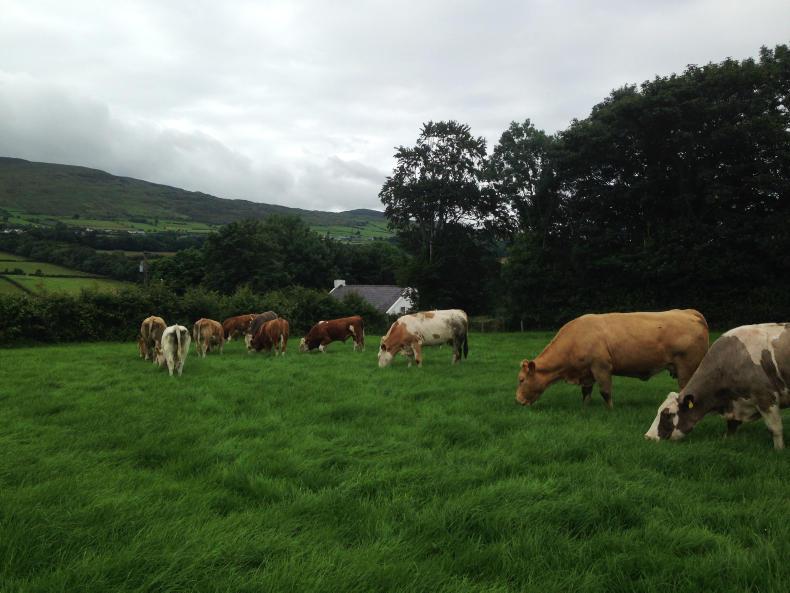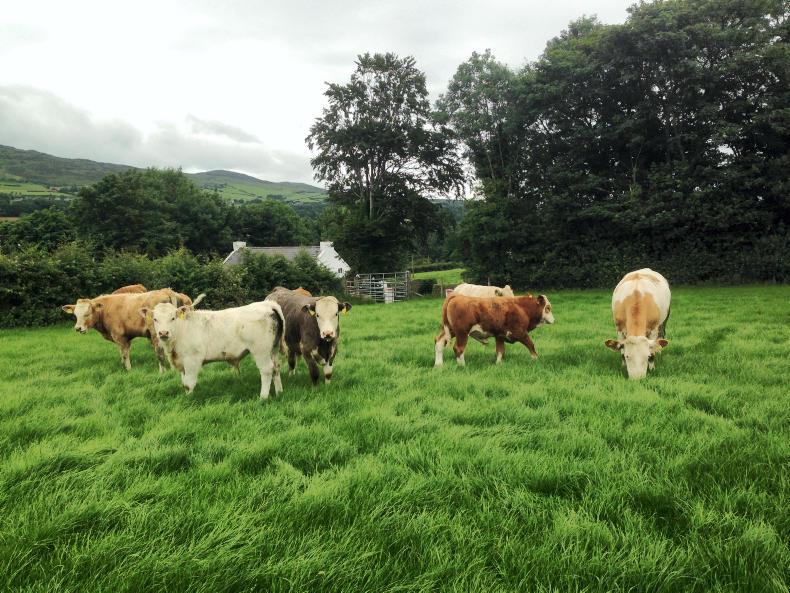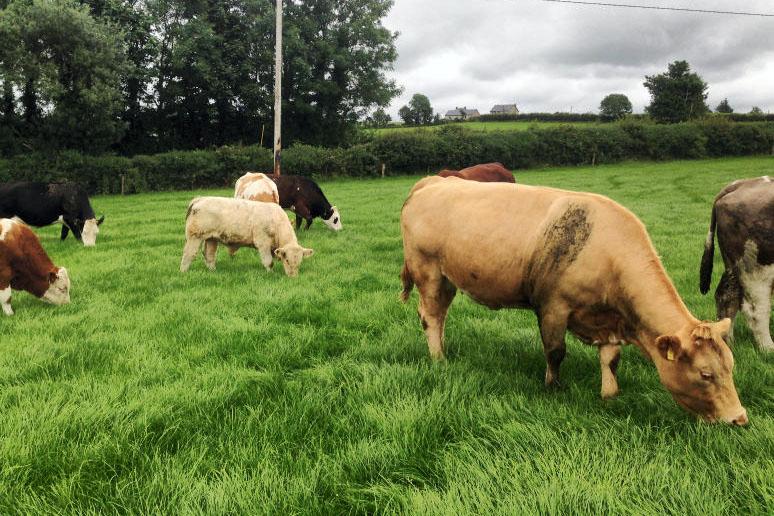Some of my land is surrounded by hardwood forestry and flies can be a huge problem. With the exception of last year, it has been something that has caused me plenty of hassle over the last five or six years.
 There is nothing worse than a maiden heifer losing a quarter or maybe two before she even calves. It more or less makes the previous two years you spent rearing her and getting her in calf a waste of time. She’s never going to produce to her full potential and is unlikely to be able to put adequate weight gain into her own calf.
There is nothing worse than a maiden heifer losing a quarter or maybe two before she even calves. It more or less makes the previous two years you spent rearing her and getting her in calf a waste of time. She’s never going to produce to her full potential and is unlikely to be able to put adequate weight gain into her own calf.
I have tried numerous preventions over the years and it’s difficult to know what works best.
Obviously, applying tar to the teats as a physical barrier should work best, but it needs to be applied at least once a week for it to be any good. This is very labour-intensive and of course can’t be used on lactating cows that are still feeding calves.
Pour-ons, fly tags and garlic buckets
I’ve tried using pour-ons containing cypermethrin or deltamethrin. I’ve also tries using fly tags, a simple soft rubbery tag that contains cypermethrin, the same active ingredient as the pour-on. It releases the active slowly over a period of time and acts as a fly deterrent.
The latest products that I’ve been trialling are garlic buckets. I use them all summer instead of high mag buckets. There is still enough magnesium in it to help prevent grass tetany, but the garlic helps to keep away the flies.
When trying to prevent summer mastitis, no one type of prevention is full proof
I know some farmers don’t rate them at all. However, what I’ve found is that when trying to prevent summer mastitis, no one type of prevention is foolproof. The more things you try, the more layers of defence you have in place, the better chance you have of escaping this dreaded scourge.
Calves weighed
I managed to get some calves weighed this week – a batch of bulls. The calves have been well grazed since going to grass full time in mid-March and were at grass by day, weather permitting, since 27 January.
They also got a mineral bolus and a worm drench in early May. They looked to be performing well, but until you get them on the bridge and calculate the average daily gain you never can be sure.
As a batch, they averaged 1.28kg liveweight per day since birth, with the best-performing calf hitting 1.45kg.
The weighbridge is an invaluable tool in establishing what level of performance you are achieving
I’m quite happy with this level of performance, but as the season progresses and the calves’ grass intake increases, I would expect these figures to increase slightly.  The weighbridge is an invaluable tool in establishing what level of performance you are achieving and helps weed out the underperformers.
The weighbridge is an invaluable tool in establishing what level of performance you are achieving and helps weed out the underperformers.
No matter how good a stock person is, there is no way they can accurately estimate animal performance by eye alone.
Read more
Watch: benefits to weighing cattle mid-season
All stories by Co Donegal beef farmer James Strain
Some of my land is surrounded by hardwood forestry and flies can be a huge problem. With the exception of last year, it has been something that has caused me plenty of hassle over the last five or six years.
 There is nothing worse than a maiden heifer losing a quarter or maybe two before she even calves. It more or less makes the previous two years you spent rearing her and getting her in calf a waste of time. She’s never going to produce to her full potential and is unlikely to be able to put adequate weight gain into her own calf.
There is nothing worse than a maiden heifer losing a quarter or maybe two before she even calves. It more or less makes the previous two years you spent rearing her and getting her in calf a waste of time. She’s never going to produce to her full potential and is unlikely to be able to put adequate weight gain into her own calf.
I have tried numerous preventions over the years and it’s difficult to know what works best.
Obviously, applying tar to the teats as a physical barrier should work best, but it needs to be applied at least once a week for it to be any good. This is very labour-intensive and of course can’t be used on lactating cows that are still feeding calves.
Pour-ons, fly tags and garlic buckets
I’ve tried using pour-ons containing cypermethrin or deltamethrin. I’ve also tries using fly tags, a simple soft rubbery tag that contains cypermethrin, the same active ingredient as the pour-on. It releases the active slowly over a period of time and acts as a fly deterrent.
The latest products that I’ve been trialling are garlic buckets. I use them all summer instead of high mag buckets. There is still enough magnesium in it to help prevent grass tetany, but the garlic helps to keep away the flies.
When trying to prevent summer mastitis, no one type of prevention is full proof
I know some farmers don’t rate them at all. However, what I’ve found is that when trying to prevent summer mastitis, no one type of prevention is foolproof. The more things you try, the more layers of defence you have in place, the better chance you have of escaping this dreaded scourge.
Calves weighed
I managed to get some calves weighed this week – a batch of bulls. The calves have been well grazed since going to grass full time in mid-March and were at grass by day, weather permitting, since 27 January.
They also got a mineral bolus and a worm drench in early May. They looked to be performing well, but until you get them on the bridge and calculate the average daily gain you never can be sure.
As a batch, they averaged 1.28kg liveweight per day since birth, with the best-performing calf hitting 1.45kg.
The weighbridge is an invaluable tool in establishing what level of performance you are achieving
I’m quite happy with this level of performance, but as the season progresses and the calves’ grass intake increases, I would expect these figures to increase slightly.  The weighbridge is an invaluable tool in establishing what level of performance you are achieving and helps weed out the underperformers.
The weighbridge is an invaluable tool in establishing what level of performance you are achieving and helps weed out the underperformers.
No matter how good a stock person is, there is no way they can accurately estimate animal performance by eye alone.
Read more
Watch: benefits to weighing cattle mid-season
All stories by Co Donegal beef farmer James Strain
 There is nothing worse than a maiden heifer losing a quarter or maybe two before she even calves. It more or less makes the previous two years you spent rearing her and getting her in calf a waste of time. She’s never going to produce to her full potential and is unlikely to be able to put adequate weight gain into her own calf.
There is nothing worse than a maiden heifer losing a quarter or maybe two before she even calves. It more or less makes the previous two years you spent rearing her and getting her in calf a waste of time. She’s never going to produce to her full potential and is unlikely to be able to put adequate weight gain into her own calf. The weighbridge is an invaluable tool in establishing what level of performance you are achieving and helps weed out the underperformers.
The weighbridge is an invaluable tool in establishing what level of performance you are achieving and helps weed out the underperformers.





 This is a subscriber-only article
This is a subscriber-only article












SHARING OPTIONS: